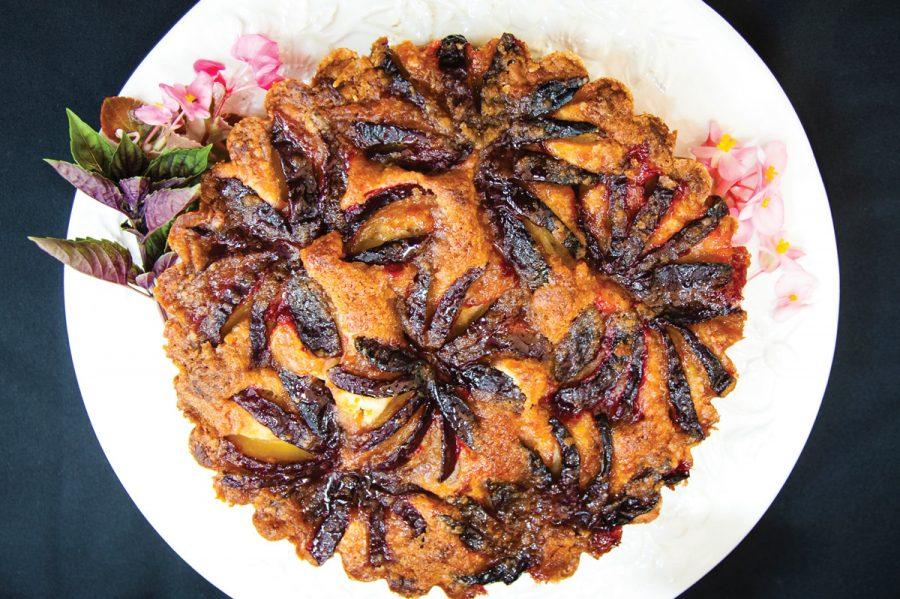Perfectly plum
Published August 19, 2015
Call them what you may – Italian prune plums, zwetschken, pflaumen, quetsches, sugar plums, Jersey black plums, empress plums – they have arrived.
These oval fruits are bluish-purple with a silvery sheen. Their flesh is greenish-brown and, when slit open, they easily relinquish their singular seed. While they are less juicy than other varieties and small enough to be devoured in just two luscious bites, no other plum will do when making the classic German pastry plum kuchen.
In season from mid-August to mid-September, you have to grab these plums while you can. A few weeks from now, the flesh of this fruit will become mushy and go from sweet to fermented. In addition to enjoying Italian prune plums as is, you can add them to most roast poultry and meat dishes, and you can substitute them for other fruits in your favorite jam, compote, salsa or holiday cake recipe. But for me, though, they rock in kuchen.
So what is kuchen? The word is German and simply means “cake.” German pastry chefs take great pride in their pastries and coffee cakes. They make some from dough mixed with yeast, and others mixed with baking powder. Both varieties rise as they bake, producing light and airy cakes.
A third variety is known as a short crust, similar to the type you might use for a pie or tart. While this short crust dough will not rise like the other two, it produces a crisper and flakier pastry.
Whichever dough you choose, all can be topped with Italian prune plums and baked to perfection.
To better understand the differences between the various types of kuchen, I spoke with our community’s resident German pastry chef, Erich Dahl, who created and perfected the legendary French onion soup at Famous-Barr during his years there as executive chef.
Dahl immigrated to the United States in 1938 to escape Nazi Germany. Having worked alongside some of the finest pastry chefs in Germany, he had baked Pflaumen kuchen, plum cakes, quite often.
“Pflaumen kuchen was a seasonal pastry that we baked around the Jewish High Holidays in Germany,” Dahl said. “Some bakeries used meurbeteig, crisp cookielike dough, and others used heifeteig, a yeast-based dough. One type produced a tender cake, and the other a crisp cake.
“The bakers I worked with combined the two styles,” he told me with pride. “That combination created cake that was both tender and crisp. We made the yeast dough first and, while it was rising, we made the cookielike dough. Our unique dough was a combination of the two.”
Dahl said German bakers always used a round tart pan for this cake and always arranged the plums cut-side up.
“After lining the pan with the dough, we fanned the pitted plums over the dough in concentric circles and sprinkled them with a mixture of cinnamon and sugar,” he said. “The resulting kuchen was superb, with beautifully scalloped edges and outstanding flavor.”
Plum kuchen is not new to me. During my childhood, my mother, Ann Lenga, made a delicious plum kuchen. I used to refer to it as “plum pizza” because the crust was thin and the halved plums that topped it resembled giant mushrooms. The ratio of crust to fruit was absolutely perfect and, because my mother sprinkled generous amounts of sugar over her kuchen before she baked it, the plums were sweet and juicy, and the crust crackled when you bit into it.
On a recent trip to my local Schnucks, I spotted Italian prune plums among the fresh California stone fruit. That is when my mouth began watering from the memories of my mother’s plum kuchen. And though I loved plum kuchen as a child, I had never thought to make it until that moment.
Unfortunately, my mother did not write down her recipe. Fortunately, there are plenty of other bakers who have and, as you might imagine, no two recipes are the same. Differences include the type of dough, the degree of sweetness, whether to use cinnamon, whether to top the kuchen with streusel and, if using streusel, how to make it.
And then is the issue of whether to bake the kuchen in a rectangular pan and serve it in squares or in a round pan and serve it in wedges. Seems like a challenge, but oh, such a sweet one.
After experimenting with a few recipes, I came up with two of my own. Trust me: If you can make a pie or a cake, you can make plum kuchen. This is one special pastry. You will want to give it a try for your own sake and for the sake of your family and friends.
And it would make an elegant dessert for your holiday meal.
Margi Lenga Kahn is the mother of five and grandmother of five. A cooking instructor at the Kitchen Conservatory, she is working on a project to preserve the stories and recipes of heritage cooks. She welcomes comments and suggestions at [email protected].















